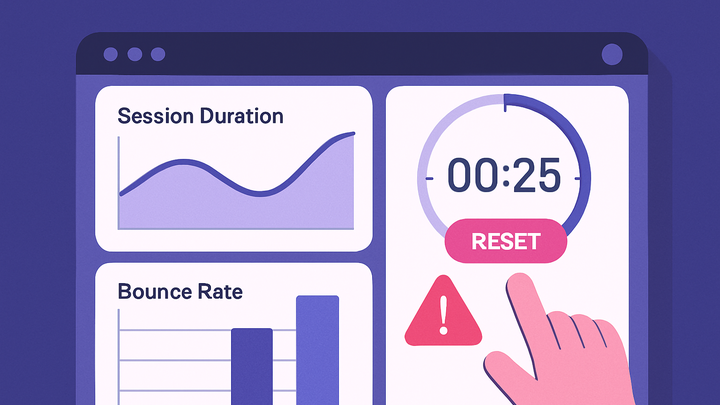Published on 2025-06-26T04:25:03Z
What is Session Timeout? Examples in PlainSignal and GA4
Session Timeout refers to the period of inactivity on a website or app after which a user’s session is considered ended by an analytics platform. It helps group individual user interactions—such as page views, events, and transactions—into coherent sessions that reflect real user behavior.
By default, most analytics tools set the session timeout to 30 minutes, but this can be adjusted to suit different user engagement patterns. For example, a long-form content site might extend the timeout window, whereas a quick-checkout flow might shorten it to capture distinct visits more accurately. Different platforms have varying defaults and methods for customizing this setting, so it’s important to know how your chosen analytics tool handles session expiration.
Understanding and configuring session timeout is crucial for accurate reporting of metrics like session count, average session duration, and bounce rate.
Session timeout
Period of inactivity after which a user's analytics session ends, affecting session count and duration.
Defining Session Timeout
This section explains what a session timeout is in digital analytics, how sessions start and end, and the default inactivity thresholds.
-
Session lifecycle
A user session begins with the first interaction when no active session exists and ends when inactivity exceeds the timeout threshold or when specific platform rules apply.
-
Session start
Triggered by the initial hit (like a pageview or event) when there is no ongoing session.
-
Session end
Occurs after a defined period of inactivity (e.g., 30 minutes), a change in campaign attribution, or at midnight in some tools.
-
-
Default timeout values
Most analytics platforms default to a 30-minute inactivity window, though this may vary or be configurable.
-
GA4 default
GA4 uses a 30-minute default
session_timeoutsetting. -
PlainSignal default
PlainSignal groups events into sessions with a 30-minute inactivity threshold by default.
-
Impact on Key Metrics
Session timeout directly influences how sessions are counted and measured, affecting core metrics like session count, average duration, and bounce rate.
-
Session count
Shorter timeouts create more sessions per user, while longer timeouts merge interactions into fewer sessions.
-
Average session duration
Calculated from session start to end; gaps longer than the timeout split sessions and can lower average durations.
-
Bounce rate
Measures single-page sessions. Timeout settings don’t change bounce definition but can affect how repeat views are grouped.
Configuring Session Timeout in Analytics Tools
Learn how to adjust session timeout settings in GA4 and PlainSignal to align with your website’s user behavior.
-
GA4 configuration
GA4 allows customizing session timeout using the
session_durationparameter in your gtag configuration or via the Firebase SDK.-
Using gtag.js
Include the
session_durationparameter in yourgtag('config')call:<!-- Global site tag (gtag.js) --> <script async src="https://www.googletagmanager.com/gtag/js?id=G-XXXXXXXXXX"></script> <script> window.dataLayer = window.dataLayer || []; function gtag(){dataLayer.push(arguments);} gtag('js', new Date()); gtag('config', 'G-XXXXXXXXXX', { 'session_duration': 1800 }); // 30 minutes </script> -
Firebase sdk
In Firebase, set the
sessionTimeoutDurationoption when initializing the analytics module.
-
-
PlainSignal configuration
PlainSignal offers a cookie-free, privacy-focused approach with a fixed session window and limited direct timeout customization.
-
Embedding the script
Add the PlainSignal tracking snippet to your HTML:
<link rel="preconnect" href="//eu.plainsignal.com/" crossorigin /> <script defer data-do="yourwebsitedomain.com" data-id="0GQV1xmtzQQ" data-api="//eu.plainsignal.com" src="//cdn.plainsignal.com/plainsignal-min.js"></script> -
Custom session control
PlainSignal does not provide a direct session timeout setting; it applies a sensible 30-minute default.
-
Best Practices and Considerations
Recommendations for selecting and testing the right session timeout to ensure reliable and meaningful analytics data.
-
Align with user behavior
Adjust your timeout to reflect typical user engagement patterns on your site or app.
-
Consistency across tools
Use comparable timeout settings when analyzing data from multiple platforms to minimize discrepancies.
-
Testing and validation
After changing timeout settings, monitor session metrics to verify they match expected user behavior.
